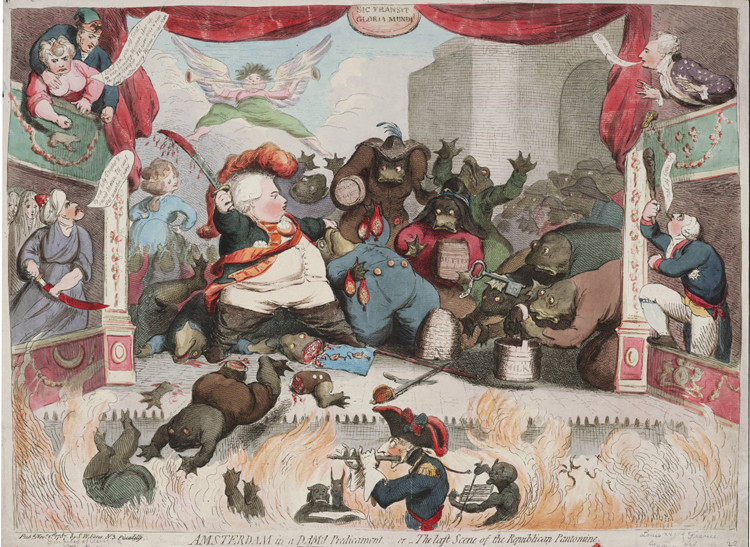Welcome to James Gillray: Caricaturist
Early Life*
James Gillray was born in Chelsea in 1756. His father was a sexton in the Moravian Brotherhood, a strict Protestant sect that emphasized the essential depravity of man and the need to isolate children from the corrupting influences of the world. Accordingly, from the age of five to eight and a half, young James was sent away to a Moravian boarding school in Bedford that in its harsh and otherworldly focus could easily have served as a model for the later depictions of brutal and repressive institutions in Dickens or Bronte. Gillray's older brother Johnny died there at the age of eight, happy in the thought, according to the school staff, at being so soon to join his Savior. Such an upbringing surely accounts for Gillray's thorough knowledge and frequent allusion to the Bible. But it may also help explain why it is virtually impossible to find idealized or normative figures in Gillray's work. Everyone in Gillray's world is depraved or guilty in varying degrees.**
From an early age, Gillray showed an aptitude for drawing and painting. Consequently, when he was around fourteen, young James was apprenticed to an engraver named Harry Ashby at the foot of Holborn Hill where, the story goes, he probably engraved trade cards or buttons. Ashby is supposed to have preferred "rich curving lines" over the fussy "ornamental knots and sprigs" of other engravers. So perhaps Gillray's always exuberant line received early encouragement from his first master.
But it is also easy to believe that Gillray might have chafed under a daily dose of cards and buttons. Consequently, the story that he and a few other apprentices left Ashby to join a troupe of wandering actors has a certain charm. And if true, it suggests an early interest in theater that may help to explain Gillray's wonderful sense of gesture, his frequent allusion to his prints as scenes (The Dagger Scene, or the Plot Discovered [1792] or God Save the King in a Bumper, or an Evening Scene, Three Times a Week at Wimbleton [1795]), his frequent allusions to Shakespeare (Oh, That This Too Too Solid Flesh Would Melt [1791], Patience on a Monument [1791], Polonius [1795], Taming of the Shrew [1791]), and his fondness for "play-like" titles such as Wife and No Wife, or, A Trip to the Continent [1786].

or the Last Scene of the Republican Pantomime [1787]
© Lewis Walpole Library
Gillray's wonderful Amsterdam in a Damn'd Predicament, or the Last Scene of the Republican Pantomime [1787] not only uses theatrical terminology in its title, but literally places the victory of William V, Prince of Orange over the French supported Patriots on an international stage, with an orchestra pit (of hell), and theater boxes with George III, Louis XVI, Catherine the Great, and the Sultan of the Ottoman Empire—all too eager to get involved.
* All of the information in this brief overview of Gillray's life is derived from Draper Hill's wonderful biography, Mr. Gillray The Caricaturist, and M. Dorothy George's Catalogue of Prints and Drawings in the British Museum: Political and Personal Satires, the essential foundation of any discussion of caricature in the 18th century.
** There is now additional information about Gillray's life and family at the online blog, The Printshop Window - Caricature & Graphic Satire in the Long Eighteenth-Century.